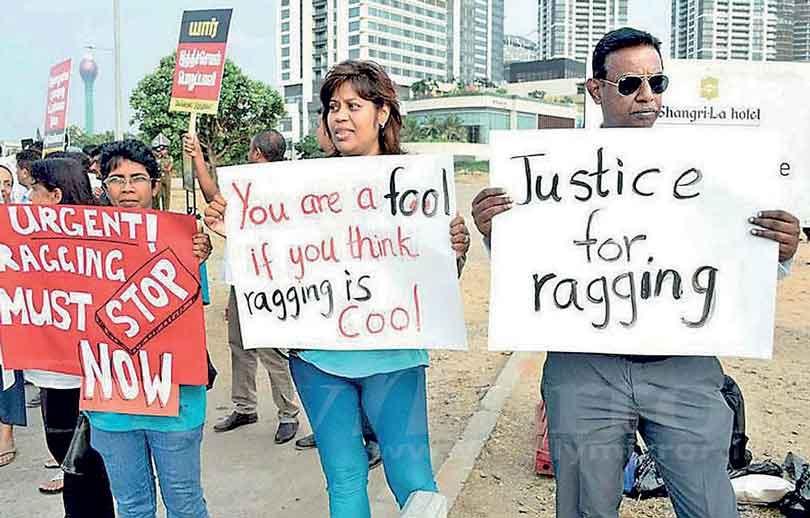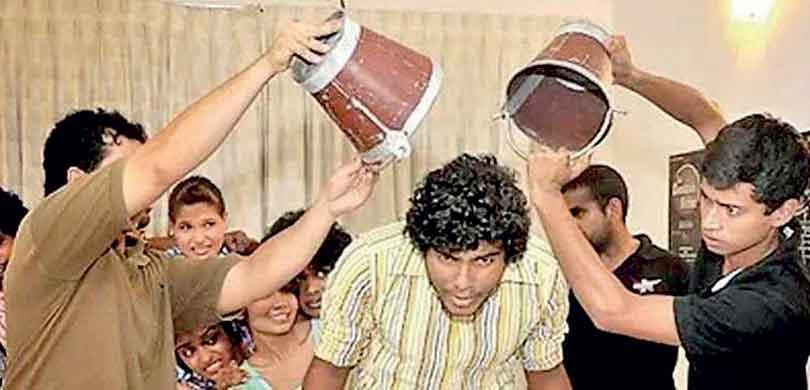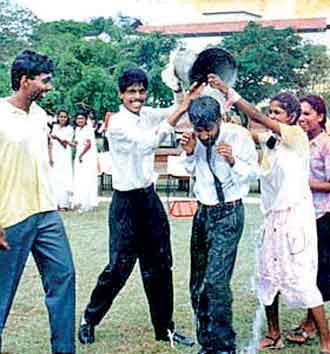


Look at Dilshi Amshika, sexually abused and then expelled from her tuition class by a so-called “progressive” leader. She took her life, and what changed? Nothing
Every religion: Buddhism, Islam, Christianity, Hinduism, talks about peace. Brotherhood. Kindness. But in the same breath, our institutions are breeding monsters in uniforms and robes
 Listen, I’m not here to sugarcoat anything. The stories coming out of Sri Lankan universities about ragging aren’t just disturbing, they’re a gut punch to everything we claim to stand for as a society.
Listen, I’m not here to sugarcoat anything. The stories coming out of Sri Lankan universities about ragging aren’t just disturbing, they’re a gut punch to everything we claim to stand for as a society.
We talk about education as the great equalizer, the golden ticket for kids from every corner of this island to rise above poverty, hardship, and history. But what happens when the very institutions meant to lift them up become battlegrounds of humiliation, violence, and even death?
Ragging is a systemic failure, a cultural cancer, and a betrayal of every student who dares to dream. And if we don’t start talking about it with the raw honesty it deserves, we’re complicit in every tragedy that follows.
1
Lives Lost, Innocence Stolen
Let’s start with the stories that haunt me. Charith Dilshan, a young man at Sabaragamuwa University, was tortured to death in 2025 for wearing shorts. Shorts. Let that sink in.
Rupa Rathnaseeli, back in 1975 at Peradeniya, jumped from a second-floor balcony to escape a sexual assault involving a candle. She survived, paralyzed, only to take her own life in 1997.
Chaminda Punchihewa and Prasaba Niroshana, both in 1993, didn’t make it out alive either. Ragging claimed them at Ruhuna University and the School of Agriculture in Angunakolapallasa.
S. Varapragash and Kelum Thushara Wijetunge, both in 1997, died from kidney failure after being forced into brutal exercises and, in Kelum’s case, excessive alcohol consumption.
Samantha Vithanage was murdered in 2002 at Sri Jayawardenepura University during an anti-ragging meeting.
An unnamed female student at Ruhuna in 2011 was left semi-paralyzed; another died by suicide the same year.
Amali Chathurika, Dilhan Wijesinghe, Shanilka Dilshan Wijesinghe, Pasindu Hirushan, D.K. Nishantha. The list goes on, each name a scar on our collective conscience. These aren’t just statistics; they’re lives snuffed out, dreams shattered, families broken.
And it’s not just universities. The rot runs deeper. At a prestigious Colombo school, a rugby freshman had a lit candle inserted into his anus and was forced to write his name with it. A grotesque “fire sacrifice” that’s still whispered about in campus corners.
At Diyatalawa military base, cadets on a train were forced into sexual acts with seniors, with the teacher in charge turning a blind eye. That teacher later became a volunteer officer during the war.
Decades later, alumni from the same school confirm this culture of forced sexual abuse persists in cadet corps. This isn’t just ragging; it’s systemic sexual violence, rooted in a colonial legacy of “fagging” that’s been twisted into something monstrous.
2
Ragging’s Vile Ritual of Sexual Control
Here’s the perspective nobody’s talking about.
Ragging in Sri Lanka isn’t just about seniors flexing power or “toughening up” freshmen. It’s a perverse performance of control, deeply tied to our society’s unspoken obsession with dominance and shame, especially around sexuality.
Think about it.
Why does so much of ragging involve sexual humiliation; stripping students, forcing them to talk about their bodies, or worse, subjecting them to acts like those candles or forced sex? It’s not random. It’s a twisted ritual where seniors, often insecure themselves, weaponize sexuality to assert dominance, especially over those who don’t fit the mold; rural kids, women, anyone who seems “different.”
This isn’t just about hazing; it’s about a culture that’s been conditioned to see submission as strength and humiliation as bonding. And it’s been festering since the British colonial era, when “fagging” in elite schools was normalized as a way to break boys into men. We’ve inherited that legacy and turned it into a nightmare.
3
Society & Religion’s Cover-Up Fuels Ragging
So why does this keep happening? Let’s talk about the elephant in the room. Our society’s silence.
We’re a nation that loves to sweep things under the rug, especially when it comes to sex and shame. Child sexual abuse in Buddhist temples? We don’t talk about it. Forced sexual acts in military ranks? Buried. Political leaders like Tissa Kuttiarachchi using vulgar metaphors for women MPs or Ranasinghe Premadasa joking about “washing the chair” if a woman became prime minister? We laugh it off.
This is a culture that’s uncomfortable with its own sexuality, so it channels that discomfort into control and violence. Ragging is just one such ugly symptom of a deeper disease. A society that’s too ashamed to confront its own perversions, so it lets them fester in our schools, universities, and even our military.
In 2022, The Buddhist and Pali University was shut down indefinitely. Why? Because students, including monk students, were involved in serious acts of ragging and indiscipline. Not one-off case. Enough to force the administration to close its doors. A statement from Ven. Neluwe Sumanawansa Thera laid it out plainly: it was ugly. It was violent. It was not what you’d expect from a so-called sacred space of learning.
And this isn’t isolated. Go back to 2018. Five monk students from the University of Ruhuna were remanded under the Anti-Ragging Act. Second years dragging a first year through hell at the Bhikkhu hostel in Eliya-Kanda.
Men who are meant to represent non-violence and compassion were instead leading ragging rituals. What are we teaching?
And it’s not just Buddhists. We watched the video. The one of a Madrasa student in eastern Sri Lanka who took his own life after brutal psychological and physical abuse by an Islamic tutor. The Madrasa shut down. The national media barely blinked. Just some TikTok videos making the rounds. That's all he got.
4
Where are we failing as a society?
Every religion: Buddhism, Islam, Christianity, Hinduism, talks about peace. Brotherhood. Kindness. But in the same breath, our institutions are breeding monsters in uniforms and robes. And the worst part? These same raggers, bullies, and cowards, many of them go on to wear suits, get elected, sit in decision-making rooms. They become “leaders.” How do you build a country when the foundation is already rotten? How do we preach peace when we tolerate cruelty in silence?
5
Some Unis Stopped Ragging. What’s Everyone Else’s Excuse?
A lawyer I spoke to, who studied at Law College some time ago, said, “They used to give seniors a month’s study leave before freshers arrived. It wasn’t something official, but it worked. No pressure, no bullying, just space for the new students to settle in. And after that, we had things like sports meets and gala dances, fun stuff that helped everyone connect naturally.”
To confirm if this is the case today, I spoke to a few other undergraduates and graduates. One of them told me; “Of course there were cultural and communal differences. Being a Muslim girl, I did feel that at times. But we were all asked to take an oath. And studying law, it made us aware. You know what’s illegal, you don’t do it. We understood human rights, and that made
a difference.”
On the other hand, it stopped me in my tracks when the same lawyer told me how Peradeniya, once infamous for brutal ragging, has turned things around.
She told me her sister had once turned down an offer from Peradeniya, years ago, because she was scared. “There were deaths. It was in the news all the time. She didn’t want to risk it,” she said.
But when I spoke to a current student, the situation sounded more structured, at least on the surface.
“Yeah, during registration, they gave us this full-page agreement we had to sign, saying we won’t take part in ragging or support it. They were very clear about it. They even told us that if we face any issues, we can go directly to the dean or any staff member. They gave us their contact numbers and everything.”
It felt official. It felt strict. And the students I spoke to seemed to believe that the university would actually take action if anything happened.
Then I spoke to another student, from the Faculty of Arts.
“As far as I know, ragging has reduced a lot. I haven’t personally experienced anything, but I’m from the English Department, which is known for being strongly anti-ragging. People usually leave us alone. Even friends from other departments have told me they haven’t been ragged.”
Still, not everything is clean-cut. “Some hostel students have talked about verbal abuse, especially in the boys’ hostels. And there are still those who identify as ‘raggers’, they wear the usual black skirts or office shoes, and they continue things like the ‘card name’ tradition.”
She recalled a recent event at the Faculty of Agriculture: “Someone asked for my card name. I just told them I’m an anti-ragger. They accepted it and walked away.”
But the issue isn’t gone. “From what I hear, ragging is still really bad in the Faculty of Engineering. Apparently, there aren’t any anti-raggers there, everyone just gets ragged.”
So, while there are signs of change, rules, support systems, and growing resistance, ragging hasn’t disappeared. It’s quieter. It's less visible in some places. But it's still there, lurking in pockets where silence allows it to survive.
And then there’s KDU.
KDU University, a defense university in Sri Lanka, isn’t playing around. They’ve got a strict anti-ragging policy grounded in the Prohibition of Ragging and Other Forms of Violence in Educational Institutions Act No. 20 of 1998. Any act that causes physical or psychological harm, student or staff, is out. No room for interpretation. It’s enforced through university rules, and if you cross the line, there are consequences. No shrugging. No sweeping under the rug. Just action.
So again: If some institutions can keep their students safe, what’s stopping the rest?
6
Ragging Thrives on Broken Promises
The Prohibition of Ragging and Other Forms of Violence in Educational Institutions Act, No. 20 of 1998, was supposed to fix this. It criminalizes ragging, with penalties up to seven years in prison.
But let’s be real: it’s a paper tiger. Enforcement is a joke. Victims don’t come forward because they’re terrified of retaliation, which is social ostracism, more abuse, or being branded as weak.
Universities set up anti-ragging committees, but they’re often toothless, staffed by insiders who don’t want to rock the boat. There’s no independent ombudsman, no mental health professionals, no external watchdogs. The police? They only step in when someone’s dead or maimed, and even then, justice is rare. Look at Dilshi Amshika, sexually abused and then expelled from her tuition class by a so-called “progressive” leader. She took her life, and what changed? Nothing.
Campus politics makes it worse. The JVP/NPP and FSP, the big players in student unions, have turned ragging into a weapon for control. It’s not about welcoming freshmen; it’s about breaking them, molding them into loyal foot soldiers for political agendas.
Yashoda Wimaladharma, an actress, was relentlessly ragged at Kelaniya University out of sheer jealousy. A professor there admits that student unions call the shots on ragging, blocking any real reform. This isn’t just bullying, its institutionalized violence, backed by political muscle.
7
So, what’s the fix?
Legislation isn’t enough. The 1998 Act exists, but without enforcement, it’s worthless.
We need a cultural revolution, and it starts with universities stepping up. First, declare a zero-tolerance policy on ragging. No exceptions, no excuses. Suspend or expel perpetrators, no matter how “senior” they are.
Second, set up safe, confidential reporting channels. Victims need to know they can speak up without being targeted.
Third, bring in mental health professionals.
Students like Amali Chathurika, Dilhan Wijesinghe or even Charith Dilshan didn’t just die because of ragging; they died because the psychological toll was ignored. Counseling isn’t a luxury, it’s a lifeline.
Fourth, educate everyone. From freshmen, seniors, staff, all must be aware of their rights and responsibilities from day one. Make it clear that ragging isn’t a joke; it’s a crime.
And fifth, break the stranglehold of student unions. Universities need to reclaim control from political groups that use ragging as a tool for dominance.
8
The Bigger Picture
We need to reframe ragging as a public health crisis. It’s not just a campus problem; it’s a societal one, with ripple effects that last a lifetime.
Anxiety, depression, PTSD; studies show these are common among ragging victims. Some never return to their studies; others carry the scars forever. And when we lose students like Charith, Rupa, or Samantha, we’re not just losing lives, we’re losing doctors, teachers, leaders who could’ve shaped our future.
We need to treat ragging like we treat epidemics: with urgency, resources, and a national commitment to eradicate it. That means funding mental health support, training staff, and launching public awareness campaigns that call out ragging for what it is. Abuse, and not tradition.
I think about one of the leaders’ sons, a boy from a prestigious Colombo school, gang-raped by party loyalists in prison during the 1971 rebellion. They called it “heroic.”
I think about the military deserters during the civil war, driven away by sexual abuse from their superiors.
I think about the rugby player with the burning candle, the cadets on the train, the freshmen
stripped and humiliated. These aren’t just stories,
they’re warnings.
I’m tired of the outrage that fades. I’m tired of the promises that go nowhere.
Sri Lankan universities should be where dreams are built, not where they’re destroyed. We owe it to Charith, Rupa, Samantha, and every other student we’ve failed to make this right.
It’s time to stop whispering behind closed doors and start shouting from the rooftops. Ragging isn’t a tradition; it’s a tragedy. And if we don’t act now, like really act, how many more names will we add to
that list?











